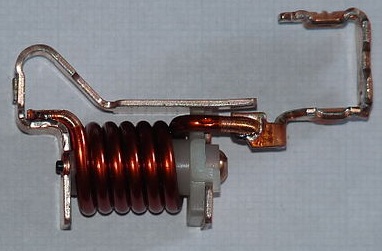Categories: Featured Articles » Electrician Secrets
Number of views: 42321
Comments on the article: 4
What to do if the circuit breaker in the electrical panel is buzzing and cracking
It happens that when you turn on a certain electrical appliance in an apartment, such as a multicooker or a lighting system with energy-saving lamps, or the power supply of a particular electrical appliance, the circuit breaker starts to buzz in the electrical panel. And usually this phenomenon is not associated either with increased power of the connected consumer, or with the corresponding current, approaching the rating of the machine. And it is connected with a certain power or with a certain household appliance.
In some cases, the hum completely disappears with an increase in load power, and often the landlord has no complaints about the smell of burning ... So, there is no arc buzzing inside the machine. And then what? Where does this hum come from? Is he dangerous? How to deal with this phenomenon and is it worth it to fight with it at all? Let's think about it.

What is buzzing there?
Everyone who is familiar with circuit breakerknows that inside it two mechanisms of protective tripping are implemented simultaneously: thermal and electromagnetic.
The thermal release mechanism is based on the gradual deformation of the bimetallic plate, which, being heated by the overload current passing through it, bends, this process is relatively inertial, however, if the current is equal to the rating of the machine, then after a few seconds the plate deforms and presses the trigger, and the cocked spring of the circuit breaker will open the circuit .
The electromagnetic trip mechanism is designed for the case of a short circuit, it is designed to instantly open the circuit, when during a short circuit the current through the electromagnetic coil reaches such a value that the spring-loaded iron core is sharply pulled into this coil, which pulls in and pulls on the same spring-loaded circuit breaker - circuit again abruptly opens.

So, since the bimetallic plate cannot hum, it does not participate in magnetization, but is only heated by the current passing through it, therefore the hum of the machine is connected to the coil.
Indeed, the iron core of the coil is always in the magnetic field acting in the protected AC circuit. If the core is not sufficiently tightened by a spring, if there is some backlash inside the circuit breaker case, then under certain conditions this core will indeed produce a rather noticeable hum.

Why is it buzzing? What are these conditions?
Firstly, if the current shape in the coil surrounding the core is distorted by the impulse load connected to the network, which gives pronounced peaks from transients, then the magnetostrictive action of such peaks will inevitably give rise to the noise of the iron core of the machine coil.
Secondly, if the core even in the cocked machine mode falls into the saturation region, then it will also buzz.
Thirdly, if the core for all this has a strong backlash, it can transmit vibration to the plastic case of the machine and to other elements of your shield.
Thus, when three conditions are combined: core saturation, strong backlash, and the presence of impulse noise, we theoretically hear maximum noise.
Who is to blame and what to do?
The answer to the question about the reason for the hum is logical: the manufacturers and developers of the humming machine did not provide all the possible nuances related to how the core will behave in the mode when the machine is in the cocked state. And there is only one way out. If you do not want to put up with noise, then you need to purchase such an automatic machine, the core of which does not hum from interference, or from play, or from probable saturation, and if it does, it is not very loud.If the buzz does not really bother you, you can leave the humming machine alone.
See also at bgv.electricianexp.com
:
